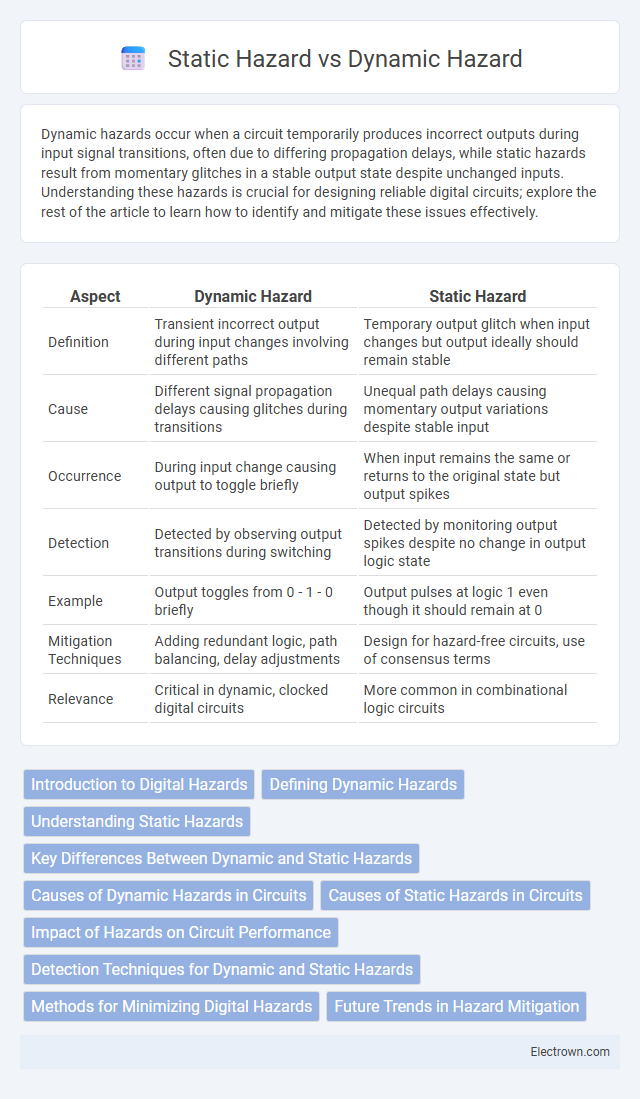Dynamic hazards occur when a circuit temporarily produces incorrect outputs during input signal transitions, often due to differing propagation delays, while static hazards result from momentary glitches in a stable output state despite unchanged inputs. Understanding these hazards is crucial for designing reliable digital circuits; explore the rest of the article to learn how to identify and mitigate these issues effectively.
Table of Comparison
| Aspect | Dynamic Hazard | Static Hazard |
|---|---|---|
| Definition | Transient incorrect output during input changes involving different paths | Temporary output glitch when input changes but output ideally should remain stable |
| Cause | Different signal propagation delays causing glitches during transitions | Unequal path delays causing momentary output variations despite stable input |
| Occurrence | During input change causing output to toggle briefly | When input remains the same or returns to the original state but output spikes |
| Detection | Detected by observing output transitions during switching | Detected by monitoring output spikes despite no change in output logic state |
| Example | Output toggles from 0 - 1 - 0 briefly | Output pulses at logic 1 even though it should remain at 0 |
| Mitigation Techniques | Adding redundant logic, path balancing, delay adjustments | Design for hazard-free circuits, use of consensus terms |
| Relevance | Critical in dynamic, clocked digital circuits | More common in combinational logic circuits |
Introduction to Digital Hazards
Digital hazards occur in combinational logic circuits when changes in input signals cause momentary incorrect outputs. Dynamic hazard refers to multiple unwanted output transitions during input changes, while static hazard involves a brief incorrect output level even though the input transitions once. Understanding these hazards is crucial for designing reliable digital systems and ensuring Your circuits operate without glitches.
Defining Dynamic Hazards
Dynamic hazards occur in digital circuits when changes in input variables cause temporary glitches or unintended transitions at the output due to varying signal arrival times. Unlike static hazards, which involve output changes from stable input states, dynamic hazards result in multiple output transitions during a single input change. These transient glitches can impact circuit reliability, making the identification and mitigation of dynamic hazards crucial in high-speed and complex digital system design.
Understanding Static Hazards
Static hazards occur in digital circuits when an output momentarily glitches despite stable input conditions, typically caused by differing signal propagation delays along redundant paths. Recognizing static hazards is essential for reliable logic design, especially in asynchronous circuits where timing inconsistencies can trigger unwanted transient outputs. Techniques to mitigate static hazards include adding hazard-free logic or employing synchronous design methodologies to ensure stable and accurate circuit behavior.
Key Differences Between Dynamic and Static Hazards
Dynamic hazards occur when a system experiences temporary glitches due to delays in signal changes, often leading to multiple undesired transitions in digital circuits, while static hazards involve momentary incorrect outputs despite stable inputs, typically caused by logic gate propagation delays. Static hazards appear as brief output glitches without input changes, whereas dynamic hazards manifest through multiple oscillations when inputs switch states. Understanding these distinctions helps optimize circuit reliability by targeting specific delay-related issues unique to dynamic or static hazard conditions.
Causes of Dynamic Hazards in Circuits
Dynamic hazards in circuits are primarily caused by differences in gate propagation delays when multiple signal paths change asynchronously, leading to transient glitches. These hazards occur as the circuit's output temporarily switches states due to uneven arrival times of input changes, especially in complex combinational logic. Factors such as gate topology, input signal transitions, and variations in gate delay contribute significantly to dynamic hazard formation.
Causes of Static Hazards in Circuits
Static hazards in circuits occur due to unequal propagation delays along different paths, causing momentary glitches when inputs change. These hazards are often caused by incomplete or simplified logic expressions that fail to cover all input conditions, leading to temporary inconsistencies in output values. Designing hazard-free circuits requires analyzing and addressing these propagation delays to ensure your circuit maintains stable output during transitions.
Impact of Hazards on Circuit Performance
Dynamic hazards cause temporary glitches in circuit output due to rapid changes in input signals, leading to incorrect transient states and potential timing errors. Static hazards result in unintended output changes when inputs remain constant, causing false switching that can degrade signal integrity and increase power consumption. Both hazards compromise circuit reliability and speed, making hazard mitigation essential for high-performance digital designs.
Detection Techniques for Dynamic and Static Hazards
Detection techniques for dynamic hazards often involve timing analysis and glitch detection methods, utilizing oscilloscopes or logic analyzers to identify short-term signal instability during circuit transitions. Static hazards are primarily detected using Boolean algebra simplification and Karnaugh maps to reveal potential logic inconsistencies that cause unwanted output changes in stable input conditions. Automated tools like hazard analyzers and formal verification systems also play a critical role in identifying both dynamic and static hazards in digital circuit designs.
Methods for Minimizing Digital Hazards
Dynamic hazard mitigation in digital circuits involves techniques such as hazard filtering, signal synchronization, and timing optimization to ensure stable output transitions. Static hazard reduction relies heavily on logic design improvements like redundant logic addition, Karnaugh map simplification, and employing hazard-free logic families. Both approaches benefit from careful analysis of circuit timing and the implementation of asynchronous design principles to minimize glitches and ensure reliable performance.
Future Trends in Hazard Mitigation
Future trends in hazard mitigation emphasize integrating advanced AI-driven predictive analytics to differentiate dynamic hazards, which change rapidly, from static hazards that remain constant. Real-time sensor networks and IoT devices enhance monitoring capabilities, enabling quicker responses to dynamic hazards such as structural vibrations or environmental shifts. Emphasis on adaptive infrastructure design and machine learning algorithms improves resilience against both hazard types, optimizing safety measures in smart cities and industrial applications.
Dynamic Hazard vs Static Hazard Infographic

 electrown.com
electrown.com